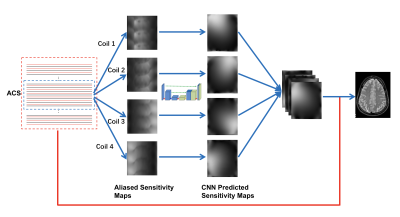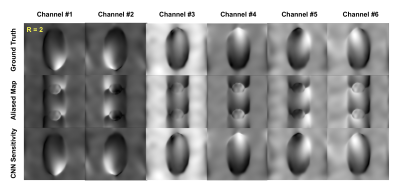3610
Calibrationless SENSE Reconstruction with Deep Coil Sensitivity Learning1Human Phenome Institute, Fudan University, Shanghai, China, 2Department of Radiology, Ruijin Hospital, Shanghai Jiao Tong University School of Medicine, Shanghai, China, 3Department of Computer Science, Yantai University, Yantai, China, 4The Third Affiliated Hospital of Nanchang University, Nanchang, China, 5Institute of Science and Technology for Brain-Inspired Intelligence, Fudan University, Shanghai, China, 6Philips Healthcare, Shanghai, China
Synopsis
Conventional SENSE requires accurate estimation of coil sensitivity maps, which remains to be a challenge in practical scenarios. This study aims to apply CNN to extract coil sensitivity information from the undersampled center k-space, and use the estimated sensitivity maps for parallel imaging. Results show that no obvious residual signal can be seen in the reconstructed images for all cases, which indicates the efficacy of the proposed method. Besides, the CNN based SENSE image without ACS appears to be less noisy than conventional SENSE results with ACS, which may benefit from the denoising effect from CNN on the sensitivity maps.
Introduction
Speed is a leading problem in MR imaging. With the utilization of parallel MRI, the scan time can be shortened with the introduction of additional sensitivity encoding. SENSE [1] is a dedicated parallel imaging technique to reconstruct full field-of-view (FOV) image from its aliased counterpart. However, conventional SENSE requires accurate estimation of coil sensitivity maps, which remains to be a challenge in practical scenarios. Besides, the sensitivity maps are obtained either by additional reference scan or by auto-calibration signal (ACS) scans, both of which will increase the imaging time and make the images vulnerable to motions.Purpose
This study aims to apply convolutional neural network (CNN) to extract coil sensitivity information from the undersampled center k-spaces, and use the estimated sensitivity maps for parallel imaging.Theory
An overview of the CNN-SENSE algorithm is presented in Figure 1. Instead of training an end-to-end image reconstruction network, we suppose the CNN to extract the features of coil sensitivities from the aliased ACS data. The consideration is that CNN based end-to-end imaging has a risk of biasing the reconstruction when there exist abnormal structures in patient image that has not been included in the training dataset. Sensitivity information, on the other hand, only reflects the geometrical distribution and sensitivity property of receiver coils, thus can be better generalized to clinical applications.In the proposed framework, the center k-space lines were extracted from the acquired k-space for the calculation of an initial guess of coil sensitivity maps. The coil sensitivity maps are estimated from zero-filled center k-space data using ESPIRiT [2]. Since the center k-spaces are sub-sampled, the roughly estimated sensitivity maps have severe aliasing artifacts as expected. Then we train a CNN model to recover the accurate sensitivity information from the aliased images channel by channel.
A modified Unet architecture was used to capture the relationship between aliased multi-coil sensitivity maps and the accurate sensitivity maps. To improve the efficiency of training, different channels of sensitivity maps were trained in a single network. The loss function is defined as below:
$$$ Loss=\frac{1}{N}\sum_{1}^{N}\left \| {f_{cnn}(z_i{;w}))-\tilde{x_{i}}} \right \|_{2}^{2}+\lambda_{w}\left \| \sum_{i=1}^{N-1}(W_{i+1}-W_{i})^{2})\right \|_{1}, [1]$$$
where $$\tilde{x_{i}}$$ denotes the ground truth sensitivity map in the i-th channel, $$f_{cnn}(z_i{;w}) $$ the CNN output, $$z_{i}$$ a aliased sensitivity map, $$W_{i}$$ the weighting parameters of the i-th channel. After obtaining the estimated coil sensitivity maps, conventional SENSE reconstruction was performed to obtain the final image.
Methods
Data AcquisitionThis study was approved by the local ethics board. Brain images were acquired from 20 subjects, each containing 30 slices. T2-weighted TSE scans were performed on a 3.0 Tesla MR system (Ingenia, Philips Healthcare, Best, The Netherlands). The following parameters were used for imaging: TR/TE = 4000/82 ms, FOV = 256 × 256 mm2, voxel size = 1.0 × 1.0 mm2, slice thickness = 2.0 mm, number of slice = 30, and flip angle = 90°. A 16 channel phase-array coil was used for signal reception. For the purpose of training, all the data were acquired without acceleration.
CNN Training
The coil sensitivity maps were calculated by using ESPIRiT [2]. To generate ground truth sensitivity maps, 48 calibration lines were with kernel size of 6×6. Undersampling was performed retrospectively. The sub-sampled ACS data were zero filled and Fourier transformed before feeding into the network. All the data were randomly grouped into a training set (80%) and a validation set (20%). Training was performed on NVIDIA Tesla V100×4 GPU (each with 32GB memory). Adam algorithm was used for gradient descent with a learning rate of 10-4 and of 0.9.
Comparison Study
For comparison, conventional SENSE[2] with calibration lines was performed.
Results
Two cases with acceleration factors of 2 and 3 are shown in Figure 2-4. For both cases, the sensitivity maps are generated from their aliased counterparts accurately (Figure 2 and Figure 4). No obvious residual signal can be seen in the reconstructed images for both cases, which indicate the efficacy of the proposed method. Besides, the CNN based SENSE image without ACS appears to be less noisy than conventional SENSE results with ACS, which may benefit from the denoising effect from CNN on the sensitivity maps.Discussion and Conclusion
This study presented a CNN-SENSE reconstruction algorithm without requirement of calibration data. The performance of the proposed reconstruction is comparable to that of conventional SENSE with full calibration lines in cases of acceleration factors of 2 and 3. Besides, the proposed method can be combined with other cascaded parallel imaging network [3-4] to further improve its performance.Acknowledgements
This work was supported by Shanghai Municipal Science and Technology Major Project (No.2017SHZDZX01), Shanghai Municipal Science and Technology Major Project (No.2018SHZDZX01) and ZJLab, Shanghai Natural Science Foundation (No. 17ZR1401600), the National Natural Science Foundation of China (No. 81971583), and National Natural Science Foundation of China (No.61902338).References
1. Pruessmann K P, Weiger M, Scheidegger M B, et al. SENSE: sensitivity encoding for fast MRI[J]. Magnetic resonance in medicine, 1999, 42(5): 952-962.
2. Uecker M, Lai P, Murphy M J, et al. ESPIRiT—an eigenvalue approach to autocalibrating parallel MRI: where SENSE meets GRAPPA[J]. Magnetic resonance in medicine, 2014, 71(3): 990-1001.
3. Aggarwal H K, Mani M P, Jacob M. Modl: Model-based deep learning architecture for inverse problems[J]. IEEE transactions on medical imaging, 2018, 38(2): 394-405.
4. Schlemper J, Caballero J, Hajnal J V, et al. A deep cascade of convolutional neural networks for dynamic MR image reconstruction[J]. IEEE transactions on Medical Imaging, 2017, 37(2): 491-503.
Figures




